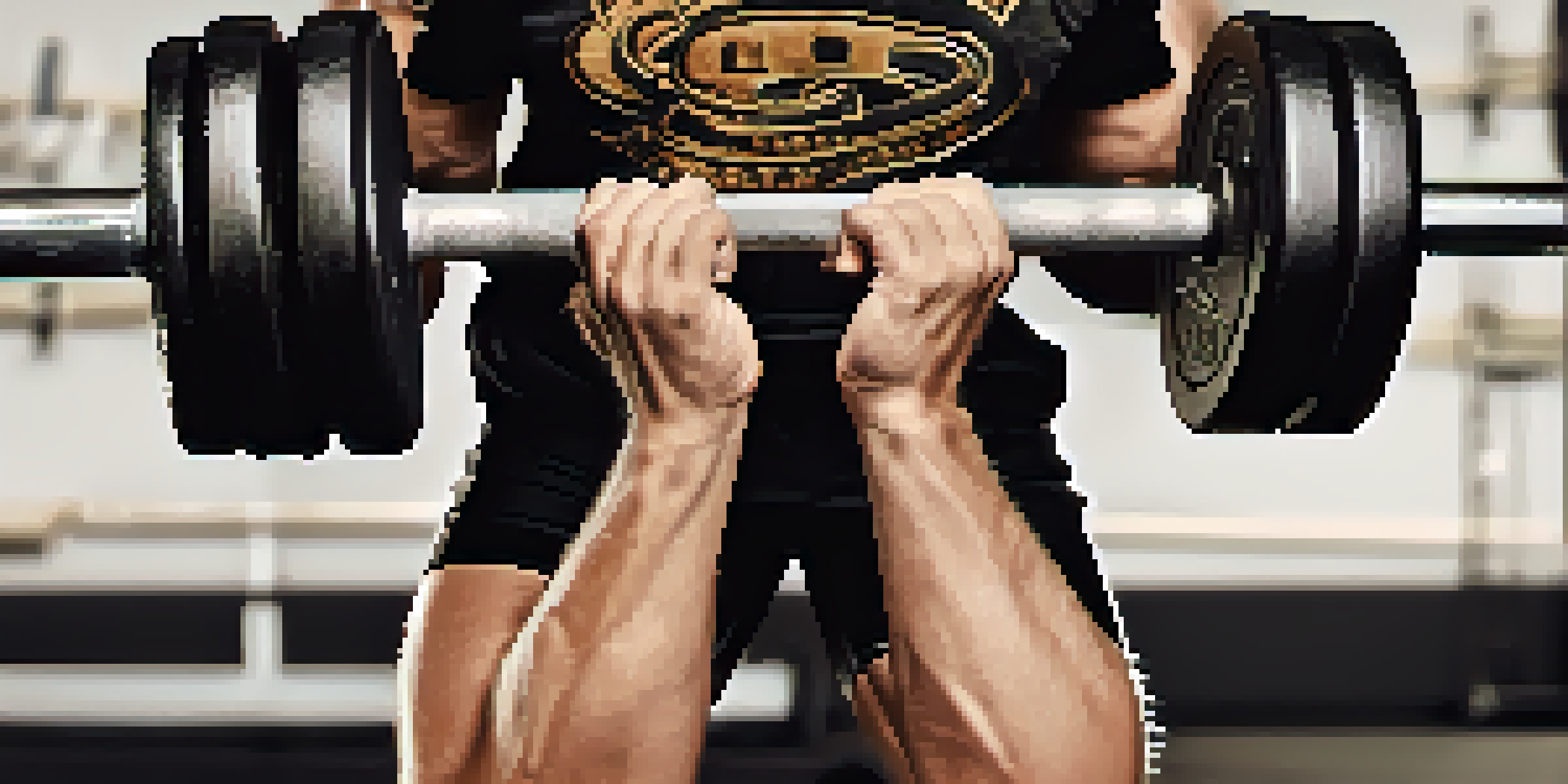Cardio's Role in Weight Management for Powerlifters

The Importance of Weight Management for Powerlifters
Weight management is crucial for powerlifters, as it impacts performance, strength, and overall health. Maintaining an optimal weight class allows lifters to compete effectively while maximizing their strength potential. Moreover, managing weight helps prevent injuries and ensures lifters can recover efficiently between training sessions.
You cannot out-exercise a bad diet.
For powerlifters, being in a specific weight class often means carefully monitoring body composition, rather than just focusing on the number on the scale. This balance between muscle mass and body fat can significantly influence their lifting capabilities. Therefore, understanding the role of different training modalities, including cardio, is vital in achieving and maintaining this balance.
Ultimately, effective weight management contributes to better performance outcomes in competitions. It’s not just about lifting weights; it's about lifting the right weights at the right body composition.
How Cardio Fits into a Powerlifter's Routine
Cardio often gets a bad rap among powerlifters who fear it might compromise their strength gains. However, when integrated thoughtfully, cardiovascular training can enhance recovery, support endurance, and aid in weight management. It's all about finding the right balance and timing within a powerlifter's training program.

Including cardio in a training regimen doesn’t mean hours of running or cycling. Short, high-intensity interval training (HIIT) or moderate steady-state sessions can be effective without detracting from strength training. This approach maintains cardiovascular fitness while preserving muscle mass, which is essential for powerlifting.
Weight Management Boosts Performance
Proper weight management is essential for powerlifters as it directly influences their performance, strength, and health.
Additionally, cardio can be strategically placed on lighter training days or as a post-lifting workout. This way, it complements strength training rather than competes with it, ensuring powerlifters can reap the benefits without sacrificing their primary goals.
Types of Cardio Beneficial for Powerlifters
Not all forms of cardio are created equal for powerlifters. Low-impact options like swimming or cycling provide cardiovascular benefits without stressing the joints and can be easier to recover from. These types of cardio can complement heavy lifting days by promoting blood flow and recovery.
The only bad workout is the one that didn’t happen.
On the other hand, high-intensity interval training (HIIT) can be particularly beneficial for powerlifters looking to shed excess body fat while maintaining muscle. HIIT workouts are time-efficient and can lead to improved metabolic rates, making them a great addition to a weight management strategy.
Ultimately, the key is to choose cardio types that align with personal goals and preferences. Finding enjoyable forms of cardio can enhance adherence and make the weight management journey more sustainable.
Cardio and Its Impact on Recovery
Recovery is an essential component of any powerlifting program, and cardio plays a significant role in facilitating this process. Engaging in light cardio can help reduce muscle soreness and stiffness after heavy lifting sessions, promoting blood circulation and nutrient delivery to the muscles. This, in turn, can enhance recovery times.
Moreover, incorporating low-intensity cardio on rest days can help powerlifters maintain their fitness levels without overtraining. Activities like walking, cycling, or swimming can serve as active recovery and keep the body engaged without exhausting it.
Cardio Aids Recovery and Fat Loss
Incorporating cardio into a powerlifter's routine can enhance recovery, support endurance, and aid in achieving optimal body composition.
In essence, cardio can be a tool for recovery rather than a hindrance, allowing powerlifters to bounce back stronger and more prepared for their next training session.
The Role of Cardio in Fat Loss for Powerlifters
For many powerlifters, achieving an ideal body composition often involves losing body fat while preserving muscle mass. Cardio can be a crucial part of this fat loss strategy, especially when combined with a well-structured diet. Creating a calorie deficit through a combination of cardio and strength training can lead to effective weight management.
Intervals of high-intensity cardio can spike metabolism and burn more calories in a shorter time, making it a powerful ally in the quest for fat loss. This approach allows powerlifters to stay within their weight class while still building strength and muscle.
However, it's essential to tailor cardio sessions to individual goals and energy levels. Overdoing cardio can lead to burnout or muscle loss, so finding the right balance is key for successful fat loss without compromising strength.
Nutrition: The Foundation of Cardio and Weight Management
Nutrition is the cornerstone of any weight management strategy, and its importance cannot be overstated for powerlifters. Cardio can enhance fat loss and overall fitness, but without proper nutrition, the results may be limited. A balanced diet rich in protein, healthy fats, and carbohydrates is crucial to fuel workouts and support recovery.
For powerlifters, understanding macronutrient ratios can help optimize performance and body composition. Consuming the right amount of protein post-cardio can aid muscle recovery and growth, while carbohydrates can replenish energy stores used during workouts.
Nutrition Supports Training Goals
A balanced diet rich in macronutrients is crucial for powerlifters to fuel their workouts and improve recovery, particularly when combined with cardio.
As such, pairing cardio with a solid nutrition plan ensures that powerlifters can achieve their weight management goals without sacrificing strength or performance. It's all about creating a holistic approach that incorporates all facets of fitness.
Listening to Your Body: Adjusting Cardio for Performance
Every powerlifter is unique, and so are their bodies' responses to training and cardio. It's essential to listen to your body and adjust cardio routines based on how you feel and your overall performance. If you're feeling fatigued or struggling to recover, it might be time to dial back the cardio intensity or frequency.
Conversely, if you're feeling great and your lifting sessions are improving, adding more cardio could enhance your conditioning and overall fitness. The key is to strike a balance that supports strength gains while reaping the benefits of cardiovascular training.

Ultimately, being mindful of your body's signals can lead to better results and a more enjoyable training experience. Adaptability is crucial in finding the perfect blend of strength and cardio for optimal performance.